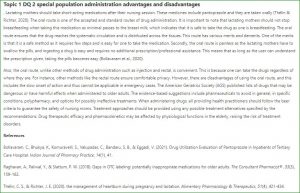Topic 1 DQ 2 Special Population Administration Advantages And Disadvantages Discussion Essay
Lactating mothers should take short-acting medications after their nursing session. These medicines include pantoprazole and they are taken orally (Thélin & Richter, 2020). The oral route is one of the accepted and standard routes of drug administration. It is important to note that lactating mothers should not stop breastfeeding when taking this medication as minimal passes to the breast milk, which indicates that it is safe to take the drug as one is breastfeeding.
The oral route ensures that the drug reaches the systematic circulation and is distributed across the tissues. This route has various merits and demerits. One of the merits is that it is a safe method as it requires few steps and is easy for one to take the medication. Secondly, the oral route is painless as the lactating mothers have to swallow the pills, and ingesting a drug is easy and requires no additional prescription/professional assistance. This means that as long as the user can understand the prescription given, taking the pills becomes easy (Bollavaram et al., 2020).
Also, the oral route, unlike other methods of drug administration such as injection and rectal, is convenient. This is because one can take the drugs regardless of where they are. For instance, other methods like the rectal route ensure comfortable privacy. However, there are disadvantages of using the oral route, and this includes the slow onset of action and thus cannot be applicable in emergency cases.
The American Geriatrics Society (AGS) published lists of drugs that may be dangerous or have harmful effects when administered to older adults. The evidence-based suggestions include pharmaceuticals to avoid in general, in specific conditions, polypharmacy, and options for possibly ineffective treatments. When administering drugs, all providing health practitioners should follow the beer criteria to guarantee the safety of nursing moms.
Treatment approaches should be provided using any possible treatment alternatives specified by the recommendations. Drug therapeutic efficacy and pharmacokinetics may be affected by physiological functions in the elderly, raising the risk of treatment disorders.
References
Bollavaram, C., Bhukya, K., Komuravelli, S., Valupadas, C., Bandaru, S. B., & Eggadi, V. (2021). Drug Utilization Evaluation of Pantoprazole in Inpatients of Tertiary Care Hospital. Indian Journal of Pharmacy Practice, 14(1), 41.
Raghavan, A., Paliwal, Y., & Slattum, P. W. (2018). Gaps in OTC labeling: potentially inappropriate medications for older adults. The Consultant Pharmacist®, 33(3), 159-162.
Thélin, C. S., & Richter, J. E. (2020). The management of heartburn during pregnancy and lactation. Alimentary Pharmacology & Therapeutics, 51(4), 421-434.
ORDER A PLAGIARISM-FREE PAPER HERE !!
Discussion Instructions
Select a special population (e.g., pediatrics, geriatrics, pregnancy, lactation). Select a route of administration (e.g., oral, IV, subcutaneous, IM, transdermal, rectal, inhalation, SL) and discuss the advantages and disadvantages of this administration route. Special population.
Give an example of a medication administered by your chosen route and a good patient candidate or rationale for choosing your given route of administration.
Take into consideration guidelines that apply to medication administration in your special population (e.g., Beer’s criteria, pregnancy and lactation categories) and discuss why you selected these guidelines. Discuss the issue of polypharmacy in the population you select.
Include the name of the medication in the subject line so that the medications can be followed.
Make sure you choose a different medication from your peers. Include references in APA format.
Please note the acceptable resources are the following:
1. Textbooks used in our course: Lehne’s Pharmacotherapeutics for Advanced Practice Nurses and Physician Assistants.
2. Peer-reviewed journal articles: New England Journal of Medicine, Diabetes educator, Journal of American Association of Nurse practitioners, UpToDate with an Author, Epocrates – drug information only.
Unacceptable resources:
- WebMD
- Emedicine.com
- DynaMed
- Stat pearls
- Medscape
- No blogs
- Educational tools for patients
- Mayo and Cleveland clinic – opinions, not evidence
- Materials aimed at the layperson.
ALSO CHECK: Importance of Statistics and Data Analytics in Health Care

